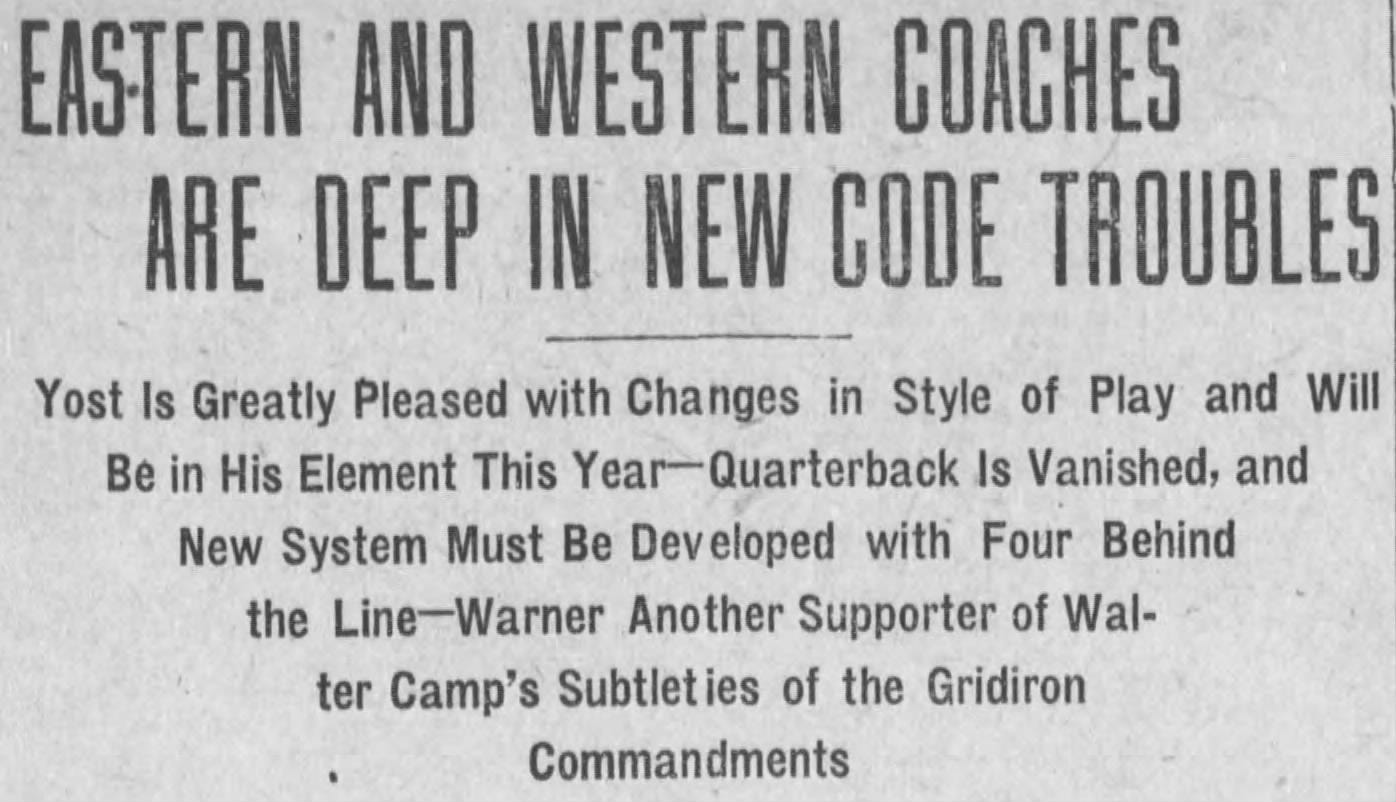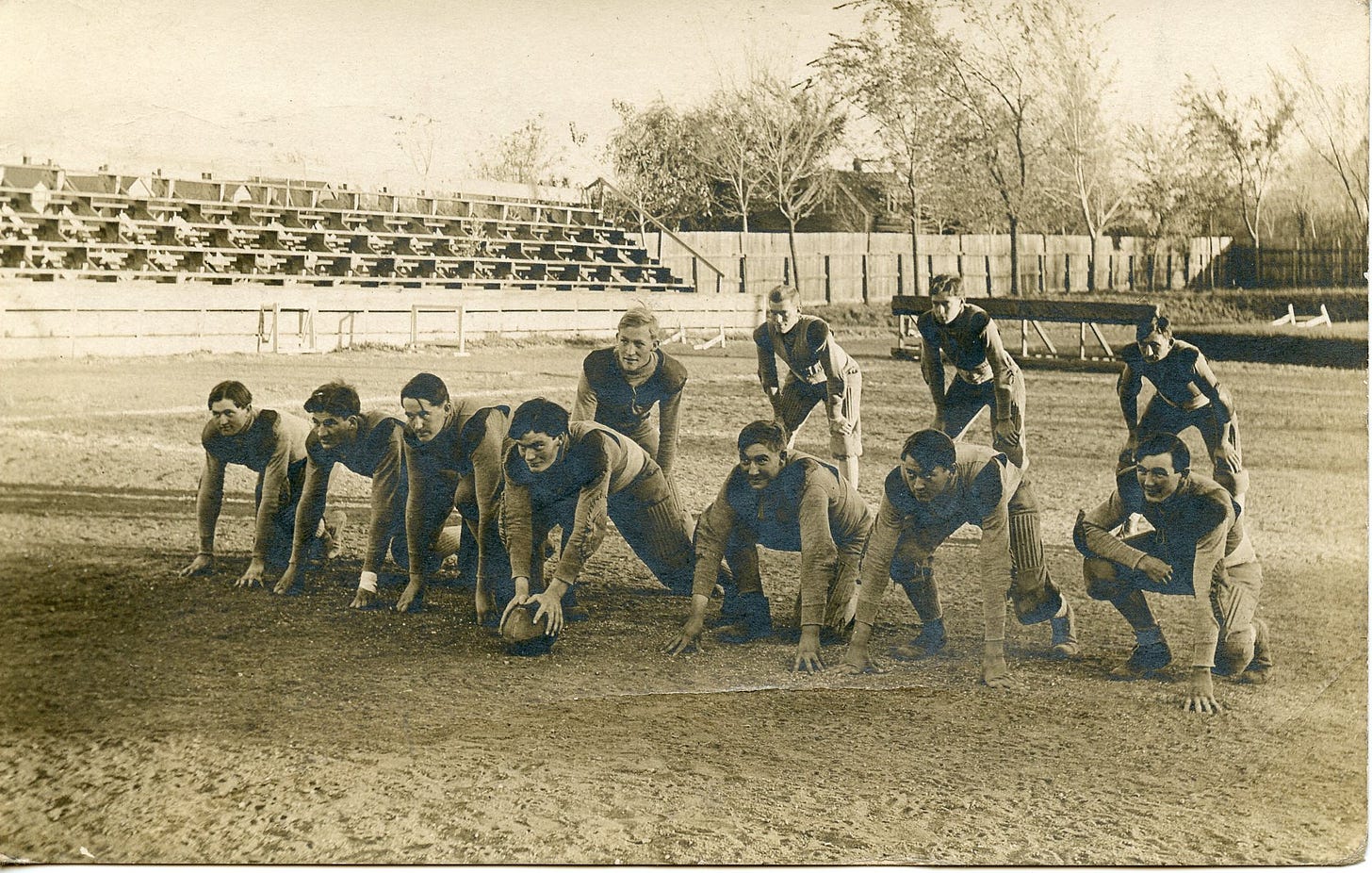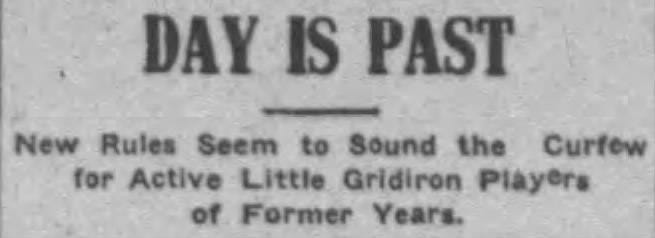Today’s Tidbit…The Year of the Disappearing Quarterback
Often, the most interesting aspects of history are not the events that happened but those that did not. One of those events discussed, considered, and attempted in 1910 was the elimination of the quarterback position.
The quarterback is the star position in football today, but that was not the case early on due to the rules in place. In the 1880s, the player receiving the snap from the center could not carry the ball forward. Only the third and subsequent players touching the ball could run it forward. Rule 30 of the 1888 Foot Ball Rule Book read:
The man who first receives the ball when snapped back from a down, or thrown back from a fair, shall not carry the ball forward under any circumstances whatever.
Early offenses generally aligned in the Traditional T formation featuring seven men close to one another on the line of scrimmage, the quarterback squatted slightly behind the snapper-back, and the three running backs lined up four or five yards behind the line of scrimmage. While teams were not required to have seven players on the line of scrimmage, most did, while other teams positioned a few of their guards, tackles, or ends behind the line of scrimmage.
To limit the game's violence, the rules committee reduced the number of blockers who could precede the runner into the hole by passing a 1903 rule requiring seven players on the line of scrimmage at the snap. The same year, they tried to open the game by allowing the player receiving the snap to keep and run with the ball, provided he crossed the line of scrimmage at least five yards to the right or left of the center. To help officials assess compliance with this rule, football fields had stripes painted every five yards running perpendicular to the yard lines, creating a checkerboard pattern.
The 1903 rule giving the player receiving the snap the right to run with the ball did not dramatically change offenses. By and large, quarterbacks still received the snap and handed the ball to teammates running between the tackles. They did the same on plays going wide. A handful of teams snapped the ball directly to a fullback or halfback who ran wide, but the approach was uncommon.
They legalized the forward pass and modified many other rules in 1906, but the game still did not become dramatically safer, leading to more rule changes in 1910. One new rule for 1910 allowed the person receiving the snap to run with the ball wherever they wanted. That rule change also eliminated the need for the checkerboard field striping, so football returned to the gridiron look with stripes every five or ten yards.
The rule allowing the player who received the snap to run the ball anywhere led coaches, reporters, and fans to speculate how offenses might change and what would become of the quarterback's role. Some suggested the quarterback would disappear as teams snapped directly to the running backs. And, if the quarterback position were to disappear, where would they position the eleventh player, what role would it take on, and what would it be called?
Previously, size did not matter for quarterbacks. They could be short, tall, slim, or fat, but they had to be clever since they called the plays. Still, many were small since they would have been halfbacks or fullbacks if they had been bigger, so some thought that teams would employ large men in the quarterback role to help them run up the middle in plays, similar to today's quarterback sneak.
The most common idea, however, was that quarterbacks would disappear. Cincinnati's coach, Bob Burch, suggested quarterbacks would pass the torch rather than the ball as offenses moved to four backfield men who could interchangeably run, pass, or block. Four backfield men allowed three to lead block or execute intricate criss-cross and other misdirection plays.
However, as the 1910 season rolled out, most coaches showed themselves to be the cautious sort. They retained their old formations and plays while creating experimental formations that eliminated the middleman with four backfield men arranged in a straight line, a crescent, an inverted wishbone, a box, or other shapes, often referring to the positions as two fullbacks and two halfbacks.

One team that went all in on the four backfield men was Colorado, under Fred Folsom. Folsom was an innovator, training his backfield men using his patented bucking strap and conducting tackling drills with his players falling into a pit filled with sawdust.
During camp and the early season, Colorado had the center snap the ball sideways rather than through the legs to reach the widely spread backs but stopped doing so when they determined the center could not block effectively after the sideways snap. Folsom intended to position four backs deep throughout the season but found his team's play more effective when one of the backs played the traditional quarterback position.

Perhaps teams did not give the no-quarterback formations enough time, allowing things to soak in and experimenting more. In the end, however, few teams had four backfield players of equal skill. Most had one whose sweeping skills were superior to the others, another with the power to buck the line, a third that passed the ball well, and a fourth that was smarter, so teams gravitated to formations and plays that took advantage of those distinct skills. It turned out that the most effective formations leveraged the talents of the Jimmies and Joes, not the theoretical Xs and Os on the chalkboard.
By 1912, Pop Warner's Carlisle formation, later known as the Single Wing, became prominent as it took advantage of players with different skills, especially one named Jim Thorpe. Later, the T formation revolutionized the quarterback role, making the quarterback the team's primary passer.
Today, we cannot imagine football without a quarterback, but things could have gone in a different direction in 1910 or any year after that, but they didn't, so we are stuck with quarterbacks until someone dreams up a formation that moves that ball more effectively than today's offenses.
Football Archaeology is reader-supported. Click here to buy one of my books or otherwise support the site.



